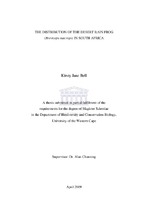| dc.description.abstract | The Distribution of the Desert Rain Frog (Breviceps macrops) in South Africa Kirsty Jane Bell M.Sc. Thesis, Department of Biodiversity and Conservation Biology, University of the Western Cape. The desert rain frog (Breviceps macrops) is an arid adapted anuran found on the west coast of southern Africa occurring within the Sandveld of the Succulent Karoo Biome. It is associated with white aeolian sand deposits, sparse desert vegetation and coastal fog. Little is known of its behaviour and life history strategy. Its distribution is recognised in the Atlas and Red Data Book of the Frogs of South Africa, Lesotho, and Swaziland as stretching from Koiingnaas in the South to Lüderitz in the North and 10 km inland. This distribution has been called into question due to misidentification and ambiguous historical records. This study examines the distribution of B. macrops in order to clarify these discrepancies, and found that its distribution does not stretch beyond 2 km south of the town of Kleinzee nor further than 6 km inland throughout its range in South Africa. The reasons for this are not clear, as there appears to be adequate habitat south of this point. Habitat suitability, food availability and competition, anthropogenic disturbance, and historical distribution patterns are discussed in terms of their impact on B. macrops distribution however no significant correlations are found. In addition, examination of the available habitat within South Africa reveals that the anthropogenic impact of strip mining for alluvial diamonds has greatly transformed much of the west coast of southern Africa including vast tracts of B. macrops habitat. Previous estimates of distribution as pertains to available habitat are found to be overly generous and this study estimates that only 21.84% of the original area remains. Thus the conservation status of this species is dire and should
be reviewed by the IUCN in light of current findings. It is the assertion of the author that the current status of Vulnerable (VU) be elevated to Endangered (EN). January 2009 | en_US |

